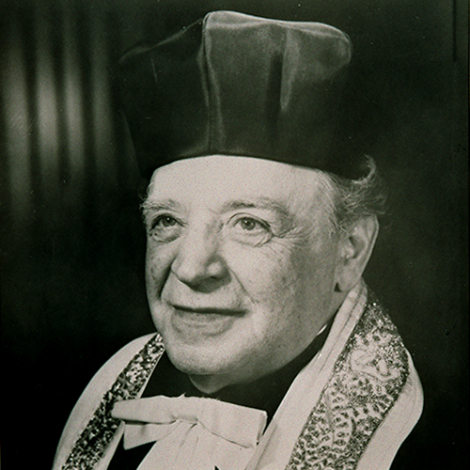Joshua Lind was a prominent cantor, a prolific composer of traditional synagogue music as well as secular Hebrew and Yiddish settings, and a teacher to many aspiring cantors. Born in Rawa Ruska, near Lemberg (Lwów), Galicia, where his father was the Lemberger shtothazzan (town cantor), he began singing in his father’s choir as a young boy. He was soon invited into the traveling cantorial choir of the eminent hazzan and composer Zeidl Rovner (1856–1943), whom Lind later credited as his de facto teacher, and the style of Lind’s hundreds of compositions bear the stamp of his years with Rovner.
Lind immigrated to America in 1913, where he was soon engaged as a cantor on New York’s Lower East Side, beginning a long and productive career. At the onset of the Great Depression, Lind took his family on the road as the Lind Family Choir, performing throughout the United States as well as in Canada—including on “Jewish Day” at the 1933 Chicago World’s Fair for an audience of nearly 80,000 at Soldier Field. He then settled in Chicago, where he became a fixture of that city’s Jewish musical life, and where his three sons became prominent cantors.
Lind was instrumental in perpetuating what used to be known as a volakh style—an unassuming tunefulness associated with cantors and choirs in Volhynia—and his compositions retained typical eastern European flavors and idioms. Apart from Rovner’s tutelage in cantorial art, Lind was completely self-taught in harmony, composition, and other musical skills, but he instinctively knew how to harmonize in a traditional and conservative way that nonetheless sustains musical interest. There is no pretension to high-art sophistication or 20th-century progressive harmonic language, but rather a tasteful expression of the emotional parameters of the texts, approached with warmth, charm, and wit. Lind had an interesting sense of humor. When he wanted emotional intensity in a certain passage, he sometimes marked it with the musical symbol mf—followed by the words in parentheses “mit feeling.”


10 thoughts on “Kaminos”
Was Nicholas related to Alexander Saslavsky who married Celeste Izolee Todd?
Anyone have a contact email for Yair Klinger or link to score for Ha-Bayta?
wish to have homeland concert video played on the big screen throughout North America.
can organize here in Santa Barbara California.
contacts for this needed and any ideas or suggestions welcomed.
Nat farber is my great grandpa 😊
Are there any movies or photos of max kletter? His wife’s sister was my stepmother, so I’m interested in seeing them and sharing them with his wife’s daughter.
The article says Sheb recorded his last song just 4 days before he died, but does not tell us the name of it. I be curious what it was. I’d like to hear it.
Would anyone happen to know where I can find a copy of the sheet music for a Gil Aldema Choral (SATB) arrangement for Naomi Shemer’s “Sheleg Al Iri”. (Snow on my Village)?
Joseph Smith
Kol Ram Community Choir, NYC
שלום שמעון!
לא שכחתי אותך. עזבתי את ישראל בפברואר 1998 כדי להביא את בני האוטיסט לקבל את העזרה המקצועית שלא הייתה קיימת אז בישראל. זה סיפור מאוד עצוב וטרגי, אבל אני הייתי היחיד עם ביצים שהביא אותו והייתי הורה יחיד בשבילו במשך חמישה חודשים. הוא היה אז בן 9. כעת הוא בן 36 ומתפקד באופן עצמאי. נתתי לו הזדמנות לעתיד נורמלי. בטח, אבות כולם חרא, אומרים הפמינציות, אבל כולם צריכים לעבוד כמטרות במטווחי רובה!
משה קונג
(Maurice King)
Thank you for this wonderful remembrance of Herman Zalis. My late father, Henry Wahrman, was one of his students. Note the correct spelling of his name for future reference. Thank you again for sharing this.
Tirza Wahrman (Mitlak)
amazing zchuso yagein aleinu, he wrote the famous niggun Lefichuch that is sung in almost every Israeli Yeshiva